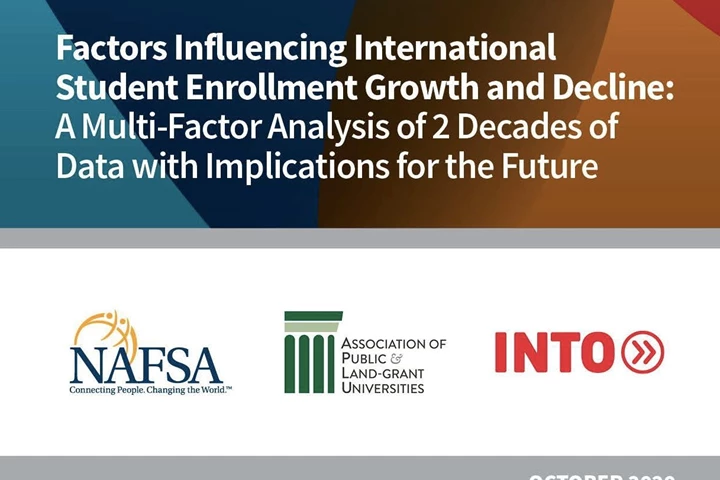NAFSA, APLU and INTO report identifies factors influencing international student enrollment and maps out ways for universities to reverse recent declines

Washington, DC
While COVID-19 and recent misguided federal policy changes are significant factors in the recent decline of international student enrollment, increased competition from other countries predates both factors and is a primary force that demands a renewed focus on internationalization from U.S. research universities, according to a new report from NAFSA: Association of International Educators, the Association of Public and Land-grant Universities; and INTO University Partnerships.
Analyzing data from nearly a dozen publicly available sources, the three groups today released, Factors Influencing International Student Enrollment Growth and Decline: A Multi-Factor Analysis of Two Decades of Data with Implications for the Future, which details the factors influencing international student enrollment levels over a period of two decades and provides a roadmap for how U.S. universities can reverse recent declines.
Among other factors, the report found that those institutions with a significant international student population already in place were able to attract additional international students. Other prominent factors include national and international recognition for institutions and whether schools have a third-party recruitment (pathway) partnership to facilitate what is often a difficult transition for international students. The report presents lessons from the past and a glimpse of future implications for international enrollment management at U.S. institutions.
Detailed findings:
Factors influencing growth
- Top-50 U.S. News and World Report-ranked institutions grew international enrollments by 5.5% between 2015 and 2018, while all other universities experienced a 1.2% decline.
- Institutions with an international student population of more than 2,500 were 1.94x more likely to experience international enrollment growth during the same period.
- Institutions with third-party pathway partnerships were 1.73x more likely to experience international enrollment growth during the same period.
Factors fueling decline
- Driven in part by a significant decrease in the number of sponsored Saudi Arabian students, international enrollments in intensive English language programs fell by 39.7% between 2015 and 2018, which contributed to a 1.2% decline in undergraduate enrollments.
- Largely due to increased U.S. visa denials and growth in Canada, the U.K. and Australia, lower numbers of Indian student enrollments drove a 3.8% decrease in international enrollments at the master’s level from 2019 to 2020.
- Increased international competition contributed to international student enrollment declines across six of the top 10 sending markets from 2019 to 2020, with the exceptions of Brazil, Canada, Taiwan and Nigeria.
Implications for the future
- Innovating new revenue streams and implementing more efficient operations will be key for universities combatting the negative economic impacts of COVID-19.
- Institutions will need an even sharper focus on delivering student outcomes and concentrating their offers on what really matters to students and their families.
- In addition to delivering classes online, institutions must find ways to recreate the cultural exchange that is integral to an international education in a digital setting.
- As student interests shift due to greater emphasis on digitalization and public health, institutions must develop solutions to offer students work experience without their being in the U.S.
- International educators must work with institutional colleagues to support long-term advocacy efforts for sensible immigration policies that welcome international students to the U.S.
For media enquiries, please contact:
Davinder Kumar
VP, Corporate & Public Relations
davinder.kumar@intoglobal.com